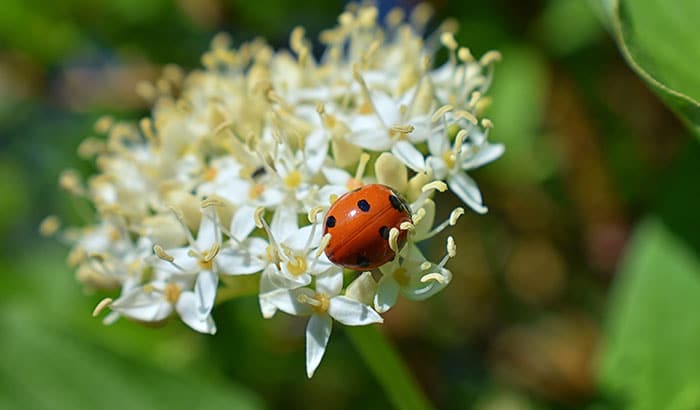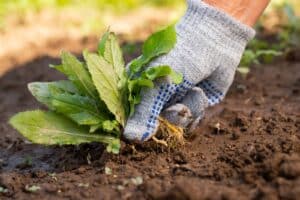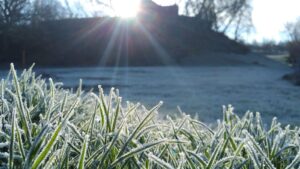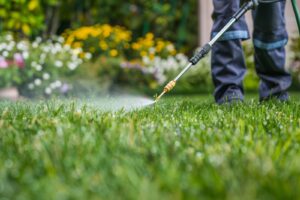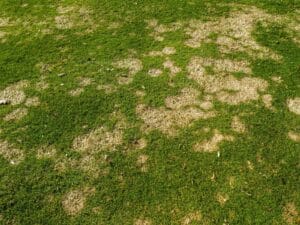With the ever-changing seasons, creepy crawlies are out to play, and the bugs in Utah are built to withstand the erratic weather patterns.
Utah is a beautiful state, but that doesn’t mean there aren’t pests around the corner to disturb you. Although many of them are harmless, finding uninvited critters on your turf can be extremely frustrating.
Here are some common Utah bugs to be aware of and how to combat them.
Grubs
Grubs are one of the most common bugs in Utah that cause lasting damage. The larvae of these parasites, called beetles, eat the roots of the grass. Destroyed roots eventually lead to dead grass as these patches spread over the remainder of the lawn.
Dead grass doesn’t always negate a grub problem– it can also be a sign that your irrigation system isn’t working properly. Here’s a quick test you can do to distinguish whether the sprinklers are to blame:
Using a can or a bucket, collect the water from your sprinkler in the middle of your grass’s dead patches. Leave the bucket there for around 15 minutes. Check to see if it has captured sprinkler water after the 15 minutes have passed. If there is water present, grubs are likely the problem.
Cockroaches
Cockroaches are constantly on the lookout for food and warmth. Because of their potential to transmit diseases, these pests can be more deadly than ants. The easiest approach to deal with roaches is to be proactive. As with ants, ensure that your food is properly stored and that there are no openings in your home through which bugs can enter. Also, declutter to remove hiding spots for roaches.
Billbugs
Billbugs are also numbered among the most common bugs in Utah. Adult billbugs are tiny insects with protruding snouts. They have wide, grayish-black bodies that range in length from 1/4 to 1/2 inch. Their larvae have no legs, are white, very tiny, and have yellowish-brown heads. Larvae are typically approximately half an inch long, with thick, fatty bodies.
Although both adult billbugs and their larvae harm turf, larvae are primarily responsible. These native Utah bugs primarily feed on grass stems, crowns, and roots, which can be extremely problematic. Green grass blades can be seen poking through the yellow splotches in yellow-tinted grass.
Take a handful of grass and pull up firmly to feel for billbugs. A large mat will make it simple to remove infested turf. The top half of the grass has been entirely severed from its roots, and the larvae will be visible on top of the dirt.
You can eliminate billbug grubs using a specific insecticide for grass grubs. Large infestations might require multiple applications so respray every few days as necessary.
Chinch Bugs
Chinches are another problematic common bug in Utah. Chinches are problematic for several reasons. Thatch, a layer of organic material that builds up on a lawn near the roots of the grass plants, is where chinchillas typically dwell.
These creatures that eat grass feed on the top and bottom portions of the blades by puncturing and sucking them. The perforated grass blades in your lawn won’t be able to exchange water with one another as a result, which will hinder the growth of your grass.
Your grass will be damaged by chinch bugs in a way that resembles a yard that isn’t getting enough water. If you routinely water your lawn and you notice your grass isn’t improving and looks dead, chances are your lawn is being taken over by chinch bugs.
Ants
Many bugs in Utah are considered nuisance pests and ants are no exception. Ants begin their annual search for refuge, warmth, and food when the weather turns colder and wetter; unfortunately, your house can offer all three.
Check your home for any gaps or crevasses where ants can enter to help stop an ant invasion. Also, make sure your food is properly stored and not left out. Crumbs and exposed fissures are a temptation for any ant colony.
Cranberry Girdler
In the middle of June, adult cranberry girdler moths appear. Females release hundreds of eggs each week after mating. In 9 to 11 days, the eggs will hatch. Larvae embed themselves in the ground and begin to eat the lawn’s roots and crowns.
The larvae spin a silk tunnel to stay warm during the cooler months. They develop into pupae in the spring to become adult webworms. When the webworms turn into moths in June, the life cycle recurs.
From late summer until the fall, these Utah bugs actively devour the crowns of the grass, destroying lawns. Due to the uneven, yellow patches of lawn it leaves behind, the damage is sometimes mistaken for drought stress.
Like checking for billbugs or white grubs, pulling up firmly on the grass will reveal the presence of cranberry girdler. The grass will grow up quickly and the roots will stay in the earth if the insect is present on your yard. The bug will be seen once the lawn has been torn up. The lawn will roll up like a rug under extreme circumstances.
Once the webworm hits the treatment, insect control will eliminate the bug that has been eating at the lawn. The grass will be dead in the winter and unable to re-grow in the spring if the lawn is left untreated through the fall and winter.
Summit Lawn and Pest Control
At Summit Lawn & Pest Control, we know the bugs in Utah can be a bit of a drag. Luckily, we have the best pest control services in Utah County to help you regain control of your turf. We are dedicated to offering quick and economical home lawn care and pest control services so you can focus on enjoying your yard rather than worrying about pesky insects and vermin.
Contact us today to book your free examination! We service Lehi, American Fork, Provo, Spanish Fork, and other Utah County cities.


